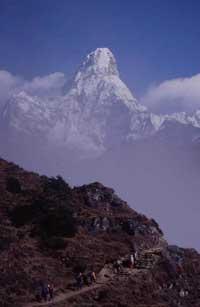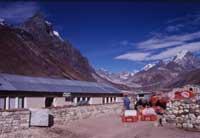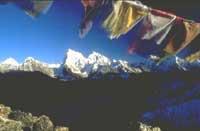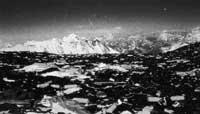Mountain disease catch you
2000/04/16 Kortabarria Olabarria, Beñardo - Elhuyar Zientzia

Like most mammals, for humans to survive, they need oxygen. A sharp decrease in the amount of oxygen that comes to it causes many brain and body processes to slow down. If the reduction of this amount is high and relatively long, brain lesions can be produced without going back to death.
To reach the summit, mountaineers have to spend a period of acclimatization, since they have to accustom the body to a low atmospheric pressure of low oxygen content. And it is that most of the time you need tiring days to climb to the top, and a few hours to go down. In addition to the state of the body, the causes of mountain disease can be other, such as climate. The decrease in temperature as it rises, the greater dryness of air when going up higher, the greater radiation of the Sun in height, etc. They can cause a disease. Logically, the most outstanding factor is altitude. Above the 2,800 meters a remarkable decrease in atmospheric pressure begins to occur and above the 4,800 meters a remarkable decrease of oxygen begins to occur. From this altitude the human being could not live, since it would alter body metabolism and would lose weight continuously.
Need for acclimatization
Without a previous acclimatization period, if you go up to 6,000 meters of a ball from the sea level, in a few minutes you will lose knowledge. If you go up higher or are too long up ready! You will immerse yourself in the arms of Herio. To exceed 3,500 to 4,000 meters it is essential that the body adapts to the low pressures of oxygen, that is, the air conditioning. This process is done slowly in approximation routes. When the approach is done quickly and abruptly, using mechanical or airborne devices, non-acclimatization can pose a risk for mountaineers.

In the time of acclimatization, respiratory and cardiac adaptation begins in the first place, since with the intention of replacing the reduction of oxygen, the heart rate increases and the respiratory rhythm increases. In turn, the hematocrit, percentage of red blood cells, increases, since with more red blood cells more oxygen can be transported. However, this occurs after a considerable time of altitude, not suddenly. The loss of physical working capacity, fluid retention, hyperventilation… are phenomena that take place during acclimatization.
Since the physical state of people is never the same, it is not possible to dictate universal rules for correct acclimatization. However, the general councils do: Climb between 350-400 meters per day to 5,000 meters; between 5,000 and 6,000 meters, a maximum of 250 meters per day; and above, between 150 and 200 meters per day. If problems appear, it is recommended to go down and rest a couple of days.
How to know that the disease comes?

The most common symptom of mountain disease is headache, the pain of the back of the head. With the movement and the rotation of the head increases the pain, in addition to having a great sensitivity to noise and light. It is considered a small demonstration of cerebral edema. In addition to headache, breathing rhythm or frequency is a clear symptom. Bad signal when the mountaineer, at rest, accelerates the respiratory rhythm. In fact, to combat the scarcity of oxygen, the body accelerates the respiratory rhythm. Insomnia and sleep arrhythmias can also be a sign of mountain disease. Sleep arrhythmia is not difficult to detect, just look at what you are sleeping: now your breathing can be fast and strong, after a few seconds the rhythm will slow down and you will soon stop breathing for a few seconds. It can be a symptom of mountain disease.
The symptoms more serious than those described, which leave the disease more patent, are: nausea, vomiting, inability to coordinate movement, decreased amount of urine, increased weight, loss of feeling of risk, sleep, etc., lungs and cerebral edemas. For mountaineers it is important to know these symptoms. For example, if a friend's attitude changes sharply, does or begins to say things that make no sense, does not pay attention to what is around… they can be symptoms of mountain disease and can pose no more danger to him and to others. In these cases it is necessary to adopt harsh, consistent attitudes, which force to descend to the one who manifests the symptoms of mountain disease.
It can often be thought that the mountaineer will not be attacked by the disease. Beliefs. Statistics reveal that half of the mountaineers who travel more than 4,300 meters of altitude have ever suffered from mountain disease. When it comes to distributing those means that have exceeded that altitude, the people who face the disease the best are the elderly, while the elderly and very young are more vulnerable. If you are going to go to the high mountains, if you do not remember the advice we have given you before.
Published in 7

Gai honi buruzko eduki gehiago
Elhuyarrek garatutako teknologia





